A Polyhydroxybutyrate (PHB)-Biochar Reactor for the Adsorption and Biodegradation of Trichloroethylene: Design and Startup Phase
Abstract
1. Introduction
2. Materials and Methods
2.1. Biochar from Pine Wood (PWB)
2.2. The Polyhydroxybutyrate (PHB)
2.3. Dehalococcoides (Dhc) Enriched Biomass
2.4. Design of the PHB-PWB Reactor
2.5. Feeding Solution and Working Conditions
2.6. Analytical Methods
2.6.1. PHB Characterization
2.6.2. Determination of the CAHs
2.6.3. Determination of Organic Acids
2.6.4. Determination of Sulfates
3. Results and Discussion
3.1. PHB Characterization
3.2. Tracer Test on the PHB-Biochar Reactor
3.3. Results from the CAHs Monitoring
3.4. Results from the Organic Acids Monitoring
3.5. Results from Sulfate Monitoring
4. Conclusions
Author Contributions
Funding
Institutional Review Board Statement
Informed Consent Statement
Data Availability Statement
Acknowledgments
Conflicts of Interest
References
- Ebrahimbabaie, P.; Pichtel, J. Biotechnology and nanotechnology for remediation of chlorinated volatile organic compounds: Current perspectives. Environ. Sci. Pollut. Res. 2021, 28, 7710–7741. [Google Scholar] [CrossRef] [PubMed]
- Dell’Armi, E.; Rossi, M.M.; Taverna, L.; Petrangeli Papini, M.; Zeppilli, M. Evaluation of the Bioelectrochemical Approach and Different Electron Donors for Biological Trichloroethylene. Toxics 2022, 10, 37. [Google Scholar] [CrossRef] [PubMed]
- Mackay, D.M.; Cherry, J.A. Groundwater contamination: Pump-and-treat remediation. Environ. Sci. Technol. 1989, 23, 630–636. [Google Scholar] [CrossRef]
- McGregor, R. Distribution of Colloidal and Powdered Activated Carbon for theIn Situ; Treatment of Groundwater. J. Water Resour. Prot. 2020, 12, 1001–1018. [Google Scholar] [CrossRef]
- Xiao, Z.; Jiang, W.; Chen, D.; Xu, Y. Bioremediation of typical chlorinated hydrocarbons by microbial reductive dechlorination and its key players: A review. Ecotoxicol. Environ. Saf. 2020, 202, 110925. [Google Scholar] [CrossRef] [PubMed]
- Petrangeli Papini, M.; Majone, M.; Arjmand, F.; Silvestri, D.; Sagliaschi, M.; Sucato, S.; Alesi, E.; Barstch, E.; Pierro, L. First pilot test on the integration of GCW (groundwater circulation well) with ENA (enhanced natural attenuation) for chlorinated solvents source remediation. Chem. Eng. Trans. 2016, 49, 91–96. [Google Scholar] [CrossRef]
- Majone, M.; Verdini, R.; Aulenta, F.; Rossetti, S.; Tandoi, V.; Kalogerakis, N.; Agathos, S.; Zanaroli, G.; Fava, F. In Situ groundwater and sediment bioremediation: Barriers and perspectives at European contaminated sites. New Biotechnol. 2015, 32, 133–146. [Google Scholar] [CrossRef]
- Field, J.A.; Sierra-Alvarez, R. Biodegradability of chlorinated solvents and related chlorinated aliphatic compounds. Rev. Environ. Sci. Biotechnol. 2004, 3, 185–254. [Google Scholar] [CrossRef]
- Lu, Q.; Yu, L.; Liang, Z.; Yan, Q.; He, Z.; Luan, T.; Liang, D.; Wang, S. Dehalococcoides as a potential biomarker evidence for uncharacterized organohalides in environmental samples. Front. Microbiol. 2017, 8, 1677. [Google Scholar] [CrossRef]
- Aulenta, F.; Rossetti, S.; Majone, M.; Tandoi, V. Detection and quantitative estimation of Dehalococcoides spp. in a dechlorinating bioreactor by a combination of fluorescent in situ hybridisation (FISH) and kinetic analysis. Appl. Microbiol. Biotechnol. 2004, 64, 206–212. [Google Scholar] [CrossRef]
- Rossi, M.M.; Dell’Armi, E.; Lorini, L.; Amanat, N.; Zeppilli, M.; Villano, M.; Petrangeli Papini, M. Combined Strategies to Prompt the Biological Reduction of Chlorinated Aliphatic Hydrocarbons: New Sustainable Options for Bioremediation Application. Bioengineering 2021, 8, 109. [Google Scholar] [CrossRef] [PubMed]
- Baric, M.; Majone, M.; Beccari, M.; Petrangeli Papini, M. Coupling of polyhydroxybutyrate (PHB) and zero valent iron (ZVI) for enhanced treatment of chlorinated ethanes in permeable reactive barriers (PRBs). Chem. Eng. J. 2012, 195, 22–30. [Google Scholar] [CrossRef]
- Amanat, N.; Matturro, B.; Rossi, M.M.; Valentino, F.; Villano, M.; Petrangeli Papini, M. Assessment of Long-Term Fermentability of PHA—Based Materials from Pure and Mixed Microbial Cultures for Potential Environmental Applications. Water 2021, 13, 897. [Google Scholar] [CrossRef]
- Mcgee, K. The Influence of In-Situ Activated Carbon on Biodegradation of Chlorinated Solvents. Ph.D. Thesis, Clemson University, Clemson, SC, USA, 2018. Available online: https://tigerprints.clemson.edu/all_theses/2925 (accessed on 20 April 2021).
- Fan, D.; Gilbert, E.J.; Fox, T. Current state of in situ subsurface remediation by activated carbon-based amendments. J. Environ. Manag. 2017, 204, 793–803. [Google Scholar] [CrossRef]
- Ciampi, P.; Esposito, C.; Viotti, P.; Boaga, J.; Cassiani, G.; Petrangeli Papini, M. An integrated approach supporting remediation of an aquifer contaminated with chlorinated solvents by a combination of adsorption and biodegradation. Appl. Sci. 2019, 9, 4318. [Google Scholar] [CrossRef]
- Zeppilli, M.; Matturro, B.; Dell’Armi, E.; Cristiani, L.; Petrangeli Papini, M.; Rossetti, S.; Majone, M. Reductive/oxidative sequential bioelectrochemical process for Perchloroethylene (PCE) removal: Effect of the applied reductive potential and microbial community characterization. J. Environ. Chem. Eng. 2021, 9, 104657. [Google Scholar] [CrossRef]
- Lai, A.; Aulenta, F.; Mingazzini, M.; Palumbo, M.T.; Petrangeli Papini, M.; Verdini, R.; Majone, M. Bioelectrochemical approach for reductive and oxidative dechlorination of chlorinated aliphatic hydrocarbons (CAHs). Chemosphere 2017, 169, 351–360. [Google Scholar] [CrossRef]
- Palma, E.; Daghio, M.; Franzetti, A.; Petrangeli Papini, M.; Aulenta, F. The bioelectric well: A novel approach for in situ treatment of hydrocarbon-contaminated groundwater. Microb. Biotechnol. 2018, 11, 112–118. [Google Scholar] [CrossRef] [PubMed]
- Ahmed, M.B.; Zhou, J.L.; Ngo, H.H.; Guo, W.; Chen, M. Progress in the preparation and application of modified biochar for improved contaminant removal from water and wastewater. Bioresour. Technol. 2016, 214, 836–851. [Google Scholar] [CrossRef]
- Wang, G.Y.; Yang, S.S.; Ding, J.; Chen, C.X.; Zhong, L.; Ding, L.; Ma, M.; Sun, G.S.; Huang, Z.L.; Ren, N.Q. Immobilized redox mediators on modified biochar and their role on azo dye biotransformation in anaerobic biological systems: Mechanisms, biodegradation pathway and theoretical calculation. Chem. Eng. J. 2021, 423, 130300. [Google Scholar] [CrossRef]
- Baric, M.; Pierro, L.; Pietrangeli, B.; Petrangeli Papini, M. Polyhydroxyalkanoate (PHB) as a slow-release electron donor for advanced in situ bioremediation of chlorinated solvent-contaminated aquifers. New Biotechnol. 2014, 31, 377–382. [Google Scholar] [CrossRef] [PubMed]
- Gwenzi, W.; Chaukura, N.; Wenga, T.; Mtisi, M. Biochars as media for air pollution control systems: Contaminant removal, applications and future research directions. Sci. Total Environ. 2021, 753, 142249. [Google Scholar] [CrossRef] [PubMed]
- Kourmentza, C.; Plácido, J.; Venetsaneas, N.; Burniol-Figols, A.; Varrone, C.; Gavala, H.N.; Reis, M.A.M. Recent advances and challenges towards sustainable polyhydroxyalkanoate (PHA) production. Bioengineering 2017, 4, 55. [Google Scholar] [CrossRef] [PubMed]
- Schreiter, I.J.; Schmidt, W.; Schüth, C. Sorption mechanisms of chlorinated hydrocarbons on biochar produced from different feedstocks: Conclusions from single- and bi-solute experiments. Chemosphere 2018, 203, 34–43. [Google Scholar] [CrossRef]
- Wang, L.; Wang, Y.; Ma, F.; Tankpa, V.; Bai, S.; Guo, X.; Wang, X. Mechanisms and reutilization of modified biochar used for removal of heavy metals from wastewater: A review. Sci. Total Environ. 2019, 668, 1298–1309. [Google Scholar] [CrossRef]
- Alfano, S.; Lorini, L.; Majone, M.; Sciubba, F.; Valentino, F.; Martinelli, A. Ethylic esters as green solvents for the extraction of intracellular polyhydroxyalkanoates produced by mixed microbial culture. Polymers 2021, 13, 2789. [Google Scholar] [CrossRef]
- Tareq, R.; Akter, N.; Azam, M.S. Biochars and Biochar Composites. In Biochar from Biomass Waste; Elsevier Inc.: Amsterdam, The Netherlands, 2019; pp. 169–209. [Google Scholar] [CrossRef]
- Khan, N.; Chowdhary, P.; Gnansounou, E.; Chaturvedi, P. Biochar and environmental sustainability: Emerging trends and techno-economic perspectives. Bioresour. Technol. 2021, 332, 125102. [Google Scholar] [CrossRef]
- Yuan, J.; Wen, Y.; Dionysiou, D.D.; Sharma, V.K.; Ma, X. Biochar as a novel carbon-negative electron source and mediator: Electron exchange capacity (EEC) and environmentally persistent free radicals (EPFRs): A review. Chem. Eng. J. 2022, 429, 132313. [Google Scholar] [CrossRef]
- Amanat, N.; Matturro, B.; Villano, M.; Lorini, L.; Rossi, M.M.; Zeppilli, M.; Rossetti, S.; Petrangeli Papini, M. Enhancing the Biological Reductive Dechlorination of Trichloroethylene with PHA from Mixed Microbial Cultures (MMC). J. Environ. Chem. Eng. 2022, 10, 107047. [Google Scholar] [CrossRef]
- Rossi, M.M.; Matturro, B.; Amanat, N.; Rossetti, S.; Petrangeli Papini, M. Coupled Adsorption and Biodegradation of Trichloroethylene on Biochar from Pine Wood Wastes: A Combined Approach for a Sustainable Bioremediation Strategy. Microorganisms 2022, 10, 101. [Google Scholar] [CrossRef]
- Aulenta, F.; Fuoco, M.; Canosa, A.; Petrangeli Papini, M.; Majone, M. Use of poly-β-hydroxy-butyrate as a slow-release electron donor for the microbial reductive dechlorination of TCE. Water Sci. Technol. 2008, 57, 921–925. [Google Scholar] [CrossRef] [PubMed]
- Chronopoulou, L.; Palocci, C.; Valentino, F.; Pettiti, I.; Petrangeli Papini, M. Stabilization of Iron (Micro) Particles with Polyhydroxybutyrate for In Situ Remediation Applications. Appl. Sci. 2016, 6, 417. [Google Scholar] [CrossRef]
- Yuan, H.-Y.; Ding, L.-J.; Zama, E.F.; Liu, P.-P.; Hozzein, W.N.; Zhu, Y.-G. Biochar Modulates Methanogenesis through Electron Syntrophy of Microorganisms with Ethanol as a Substrate. Environ. Sci. Technol. 2018, 52, 12198–12207. [Google Scholar] [CrossRef]
- Wang, C.; Liu, Y.; Wang, C.; Xing, B.; Zhu, S.; Huang, J.; Xu, X.; Zhu, L. Biochar facilitates rapid restoration of methanogenesis by enhancing direct interspecies electron transfer after high organic loading shock. Bioresour. Technol. 2021, 320, 124360. [Google Scholar] [CrossRef] [PubMed]
- Luz, F.C.; Cordiner, S.; Manni, A.; Mulone, V.; Rocco, V. Biochar characteristics and early applications in anaerobic digestion-a review. J. Environ. Chem. Eng. 2018, 6, 2892–2909. [Google Scholar] [CrossRef]
- Silvani, L.; Vrchotova, B.; Kastanek, P.; Demnerova, K.; Pettiti, I.; Petrangeli Papini, M. Characterizing Biochar as Alternative Sorbent for Oil Spill Remediation. Sci. Rep. 2017, 7, 43912. [Google Scholar] [CrossRef]
- Rossi, M.M.; Silvani, L.; Amanat, N.; Petrangeli Papini, M. Biochar from Pine Wood, Rice Husks and Iron-Eupatorium Shrubs for Remediation Applications: Surface Characterization and Experimental Tests for Trichloroethylene Removal. Materials 2021, 14, 1776. [Google Scholar] [CrossRef]
- Silvani, L.; di Palma, P.R.; Eek, E.; Riccardi, C.; Hale, S.E.; Viotti, P.; Petrangeli Papini, M. Use of biochar as alternative sorbent for the active capping of oil contaminated sediments. J. Environ. Chem. Eng. 2017, 5, 5241–5249. [Google Scholar] [CrossRef]
- Matturro, B.; Pierro, L.; Frascadore, E.; Petrangeli Papini, M.; Rossetti, S. Microbial community changes in a chlorinated solvents polluted aquifer over the field scale treatment with poly-3-hydroxybutyrate as amendment. Front. Microbiol. 2018, 9, 1664. [Google Scholar] [CrossRef]
- Pierro, L.; Matturro, B.; Rossetti, S.; Sagliaschi, M.; Sucato, S.; Alesi, E.; Bartsch, E.; Arjmand, F.; Petrangeli Papini, M. Polyhydroxyalkanoate as a slow-release carbon source for in situ bioremediation of contaminated aquifers: From laboratory investigation to pilot-scale testing in the fi eld. N. Biotechnol. 2017, 37, 60–68. [Google Scholar] [CrossRef]
- Ritalahti, K.M.; Amos, B.K.; Sung, Y.; Wu, Q.; Koenigsberg, S.S.; Löffler, F.E. Quantitative PCR targeting 16S rRNA and reductive dehalogenase genes simultaneously monitors multiple Dehalococcoides strains. Appl. Environ. Microbiol. 2006, 72, 2765–2774. [Google Scholar] [CrossRef] [PubMed]
- Matturro, B.; Heavner, G.L.; Richardson, R.E.; Rossetti, S. Quantitative estimation of Dehalococcoides mccartyi at laboratory and field scale: Comparative study between CARD-FISH and Real Time PCR. J. Microbiol. Methods 2013, 93, 127–133. [Google Scholar] [CrossRef] [PubMed]
- Matturro, B.; Majone, M.; Aulenta, F.; Rossetti, S. Correlations between maximum reductive dechlorination rates and specific biomass parameters in Dehalococcoides mccartyi consortia enriched on chloroethenes PCE, TCE and cis-1,2-DCE. FEMS Microbiol. Ecol. 2021, 97, fiab064. [Google Scholar] [CrossRef]
- Zeppilli, M.; Dell’Armi, E.; Cristiani, L.; Petrangeli Papini, M.; Majone, M. Reductive/oxidative sequential bioelectrochemical process for perchloroethylene removal. Water 2019, 11, 2579. [Google Scholar] [CrossRef]
- Mao, X.; Polasko, A.; Alvarez-Cohen, L. Effects of sulfate reduction on trichloroethene dechlorination by Dehalococcoides-containing microbial communities. Appl. Environ. Microbiol. 2017, 83, e03384-16. [Google Scholar] [CrossRef]
- Lai, A.; Verdini, R.; Aulenta, F.; Majone, M. Influence of nitrate and sulfate reduction in the bioelectrochemically assisted dechlorination of cis-DCE. Chemosphere 2015, 125, 147–154. [Google Scholar] [CrossRef]
- Aulenta, F.; Beccari, M.; Majone, M.; Petrangeli Papini, M.; Tandoi, V. Competition for H2 between sulfate reduction and dechlorination in butyrate-fed anaerobic cultures. Process Biochem. 2008, 43, 161–168. [Google Scholar] [CrossRef]
- Brown, R.A.; Mueller, J.G.; Seech, A.G.; Henderson, J.K.; Wilson, J.T. Interactions between biological and abiotic pathways in the reduction of chlorinated solvents. Remediation 2009, 20, 9–20. [Google Scholar] [CrossRef]
- Barham, P.J.; Keller, A.; Otun, E.L.; Holmes, P.A. Crystallization and morphology of a bacterial thermoplastic: Poly-3-hydroxybutyrate. J. Mater. Sci. 1984, 19, 2781–2794. [Google Scholar] [CrossRef]
- Carrasco, F.; Dionisi, D.; Martinelli, A.; Majone, M. Thermal stability of polyhydroxyalkanoates. J. Appl. Polym. Sci. 2006, 100, 2111–2121. [Google Scholar] [CrossRef]
- Erceg, M.; Kovačić, T.; Klarić, I. Thermal degradation of poly(3-hydroxybutyrate) plasticized with acetyl tributyl citrate. Polym. Degrad. Stab. 2005, 90, 313–318. [Google Scholar] [CrossRef]
- Righetti, M.C.; Tombari, E.; di Lorenzo, M.L. The role of the crystallization temperature on the nanophase structure evolution of poly[(R)-3-hydroxybutyrate]. J. Phys. Chem. B 2013, 117, 12303–12311. [Google Scholar] [CrossRef] [PubMed]
- Wu, Y.; Tatsumoto, H.; Aikawa, M. Modeling of tetrachloroethylene degradation by anaerobic granular biological activated carbon. J. Health Sci. 2000, 46, 434–440. [Google Scholar] [CrossRef][Green Version]
- Dalahmeh, S.S.; Alziq, N.; Ahrens, L. Potential of biochar filters for onsite wastewater treatment: Effects of active and inactive biofilms on adsorption of per- and polyfluoroalkyl substances in laboratory column experiments. Environ. Pollut. 2019, 247, 155–164. [Google Scholar] [CrossRef]
- Weatherill, J.J.; Atashgahi, S.; Schneidewind, U.; Krause, S.; Ullah, S.; Cassidy, N.; Rivett, M.O. Natural attenuation of chlorinated ethenes in hyporheic zones: A review of key biogeochemical processes and in-situ transformation potential. Water Res. 2018, 128, 362–382. [Google Scholar] [CrossRef]
- Aulenta, F.; Reale, P.; Catervi, A.; Panero, S.; Majone, M. Kinetics of trichloroethene dechlorination and methane formation by a mixed anaerobic culture in a bio-electrochemical system. Electrochim. Acta. 2008, 53, 5300–5305. [Google Scholar] [CrossRef]
- Aulenta, F.; Pera, A.; Rossetti, S.; Petrangeli Papini, M.; Majone, M. Relevance of side reactions in anaerobic reductive dechlorination microcosms amended with different electron donors. Water Res. 2007, 41, 27–38. [Google Scholar] [CrossRef]
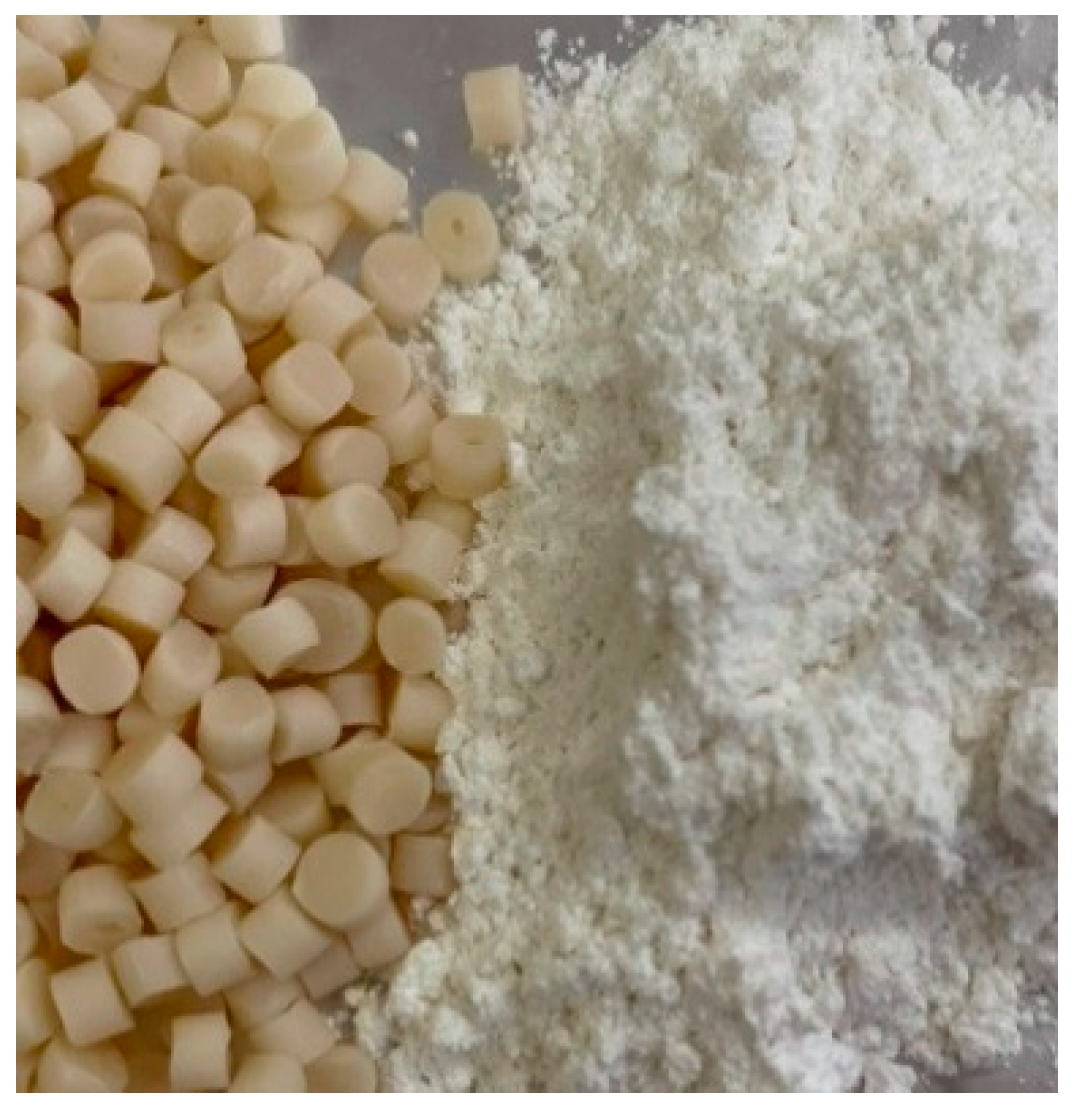

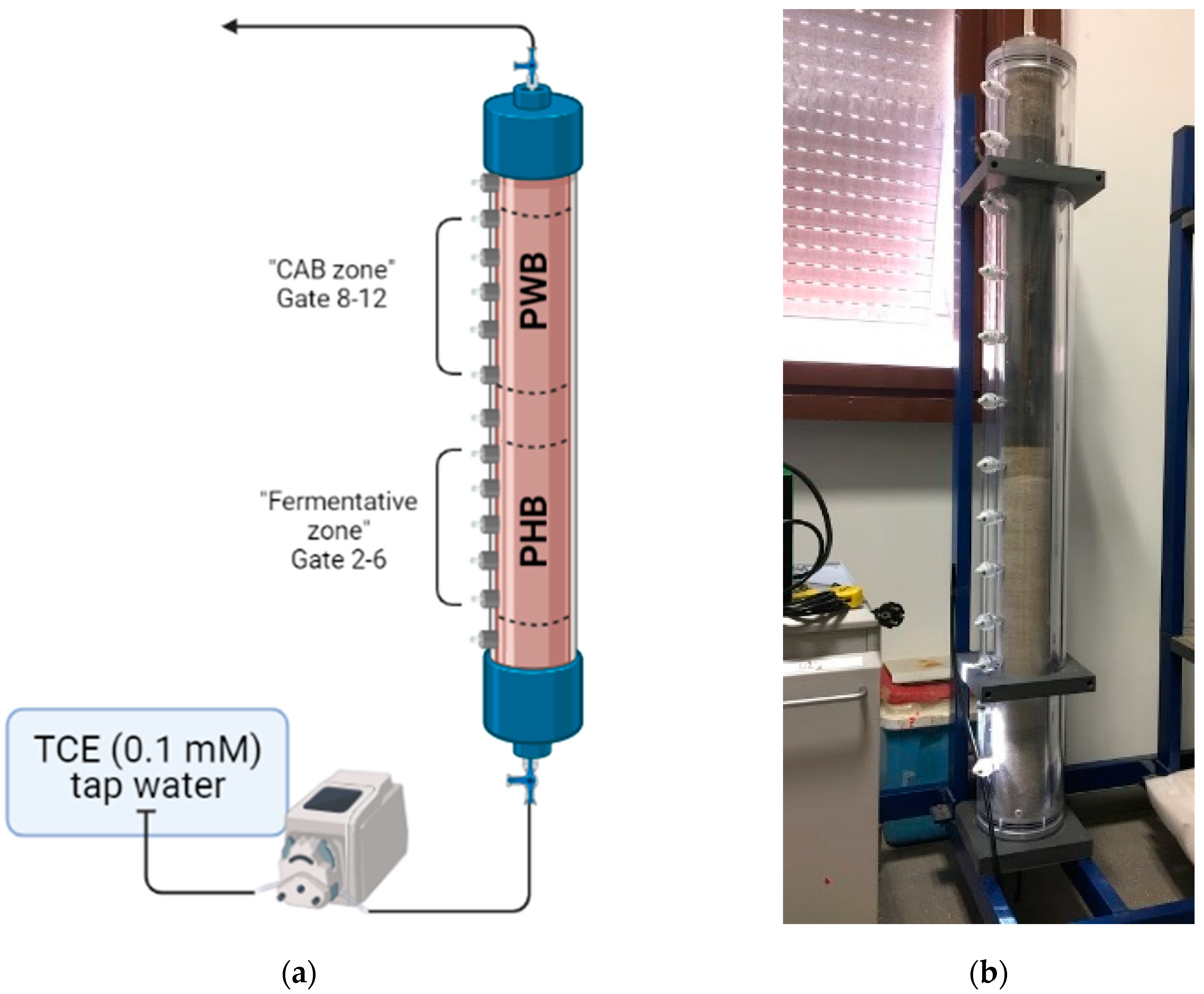
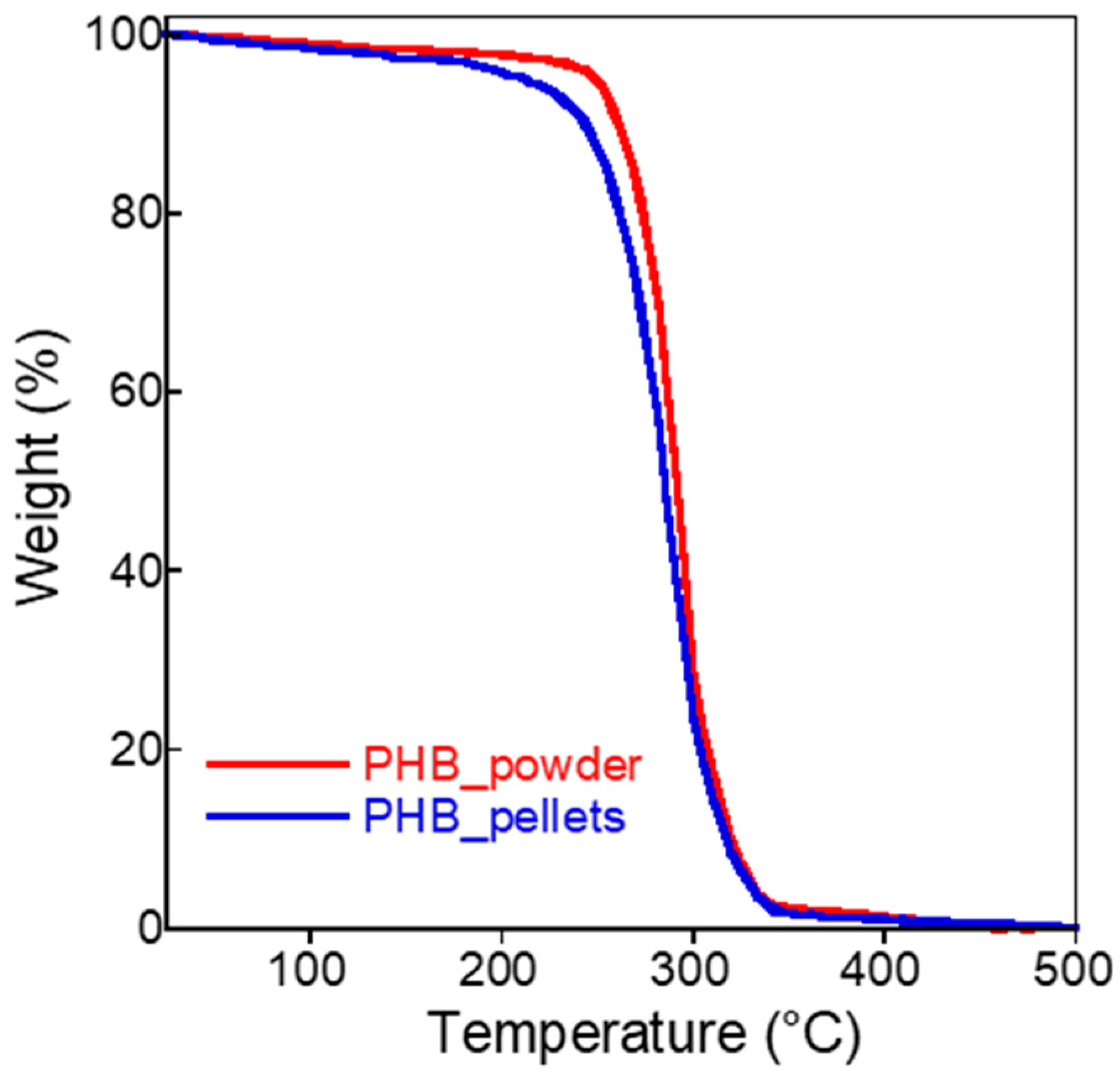
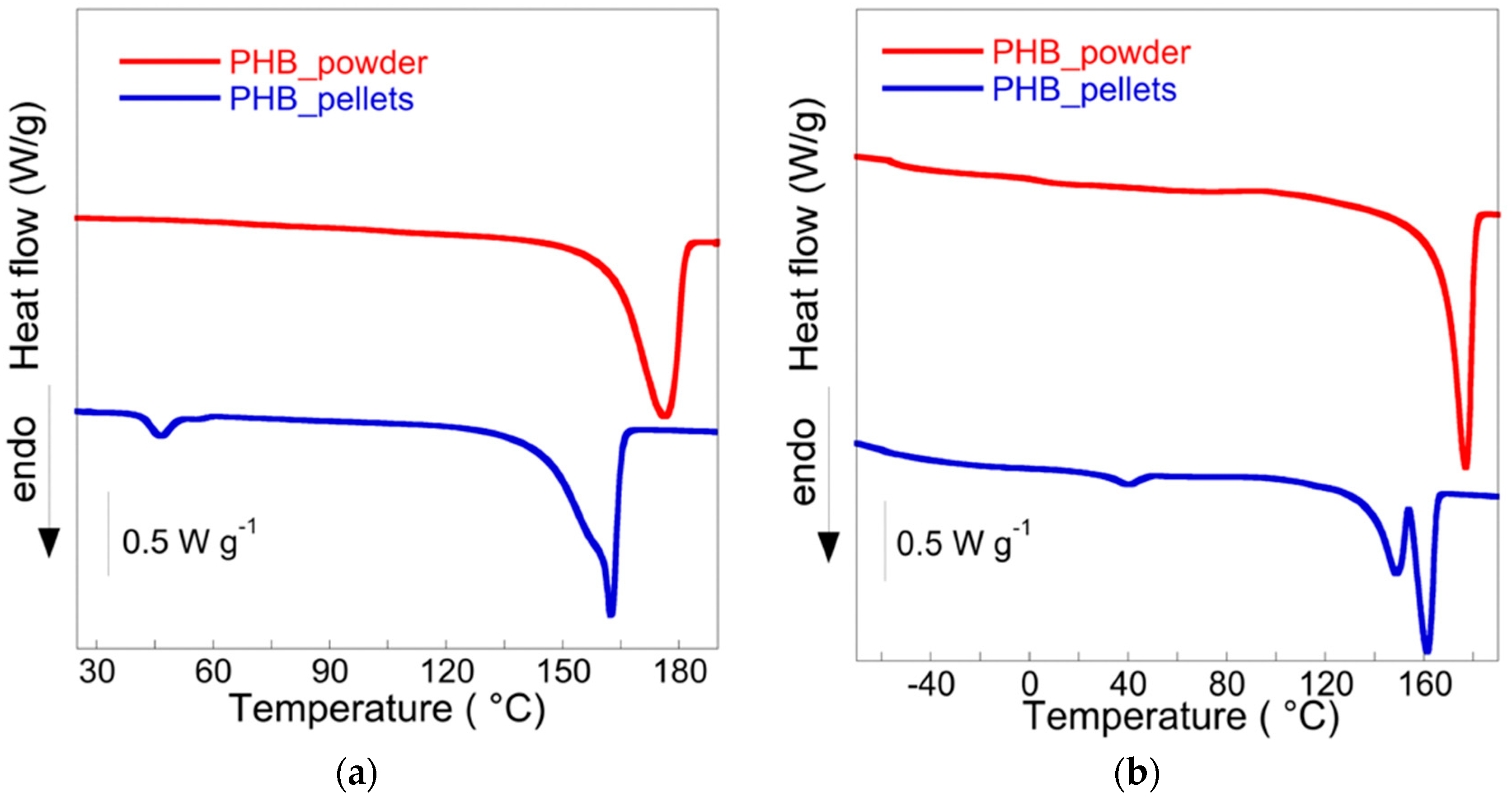



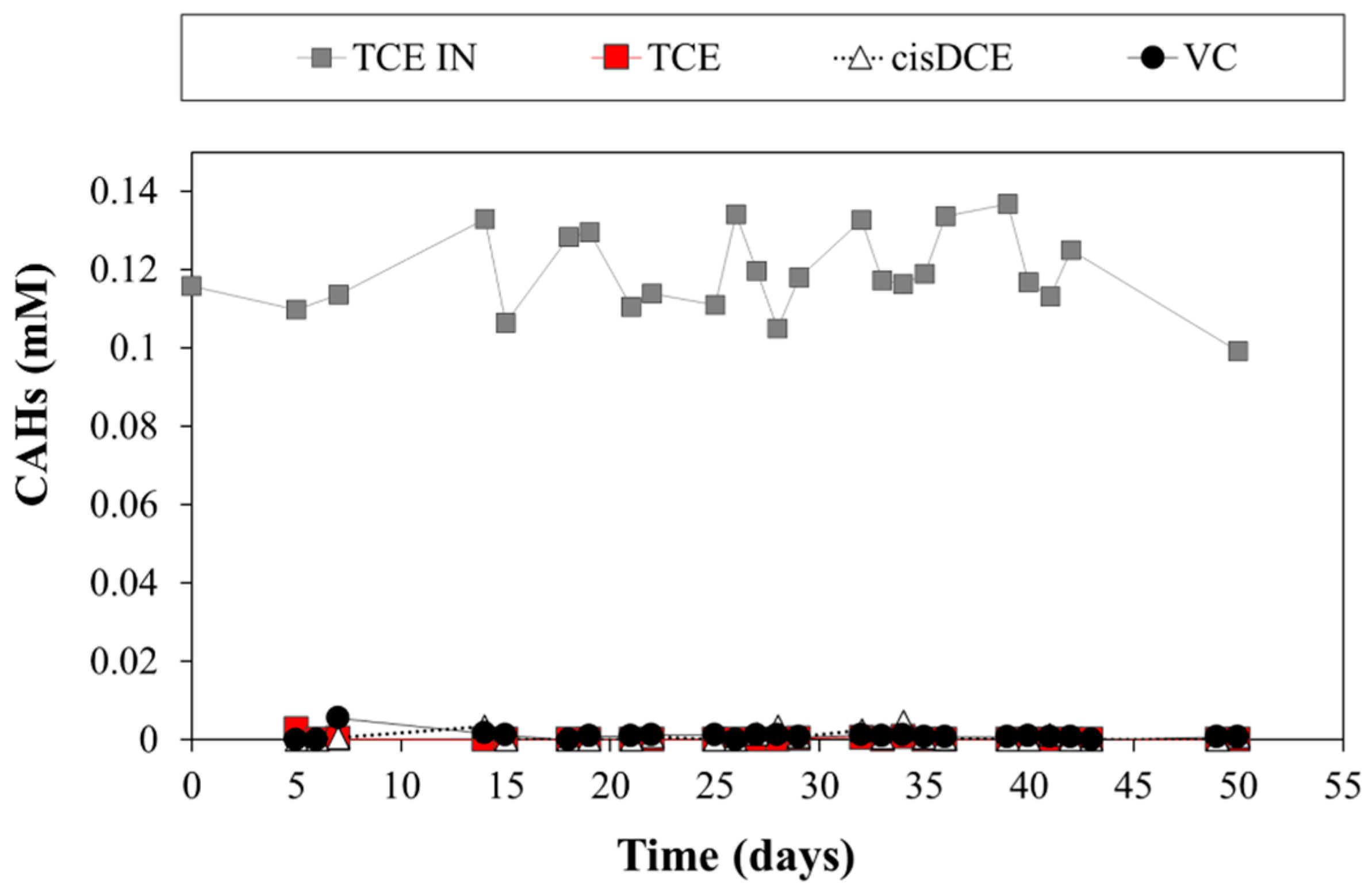
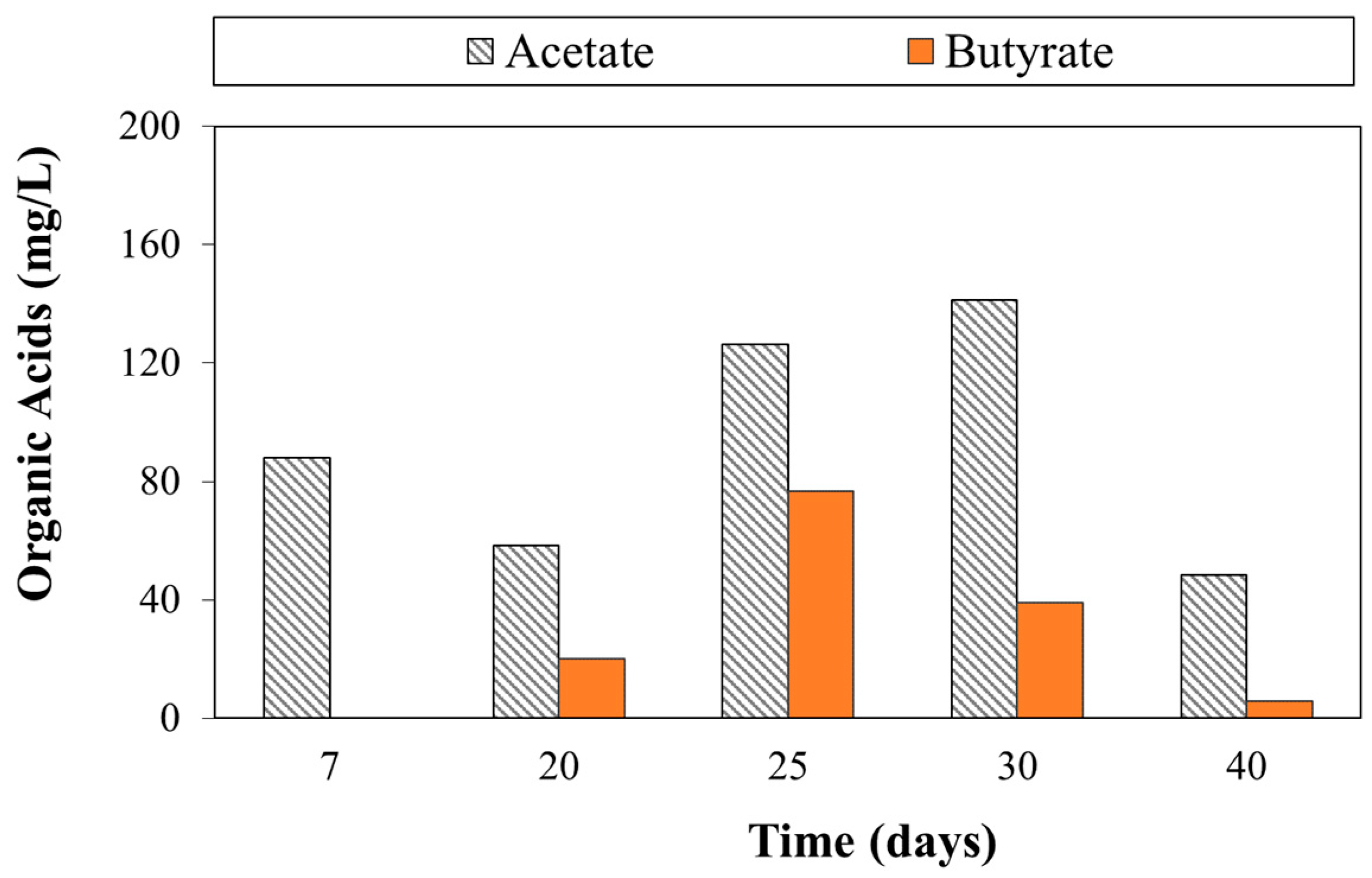
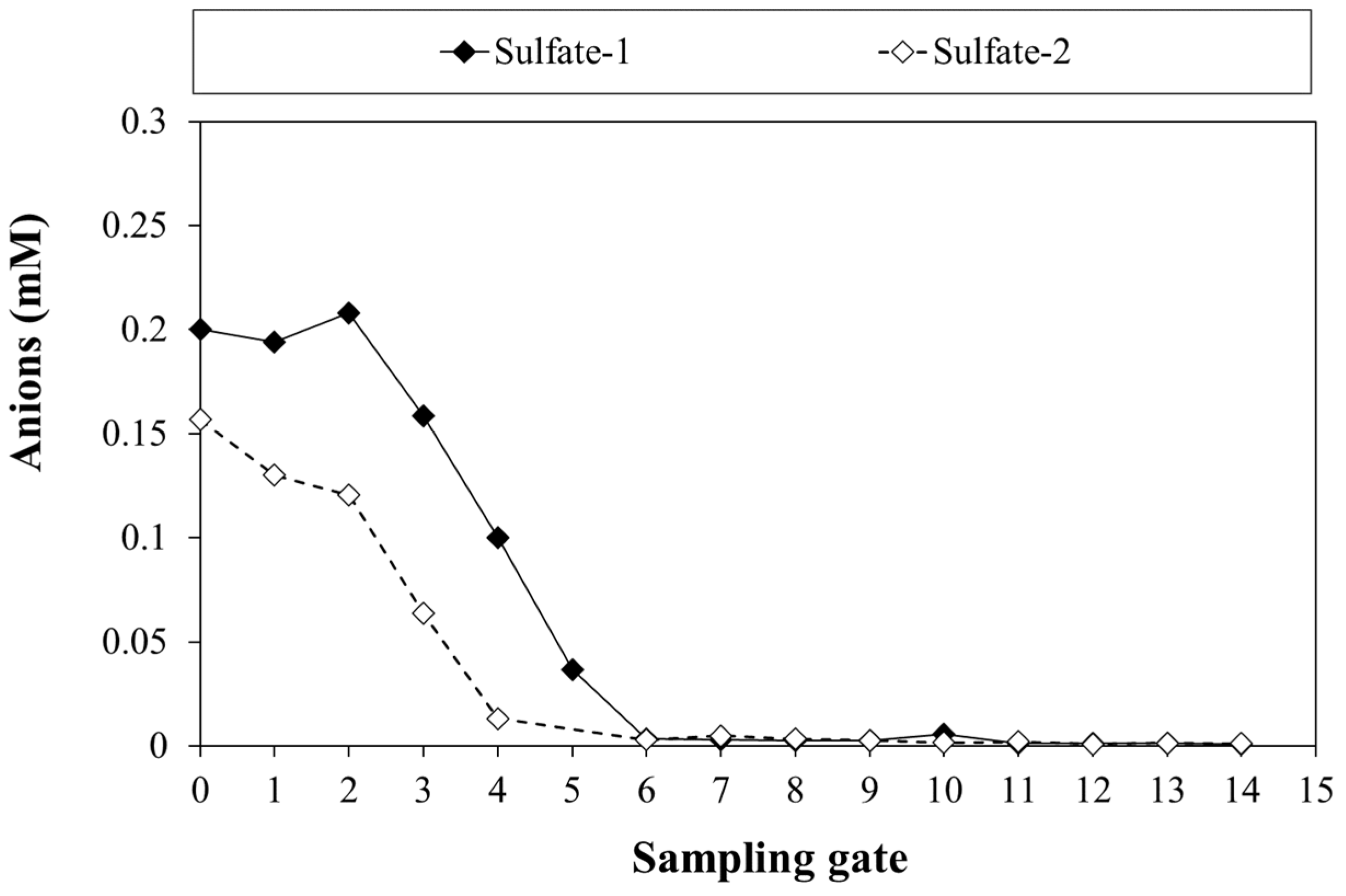
| PHB-BC Reactor Working Conditions | |
|---|---|
| Flow rate (L/day) | 6 |
| HRT (day) | 1.8 |
| TCE in (mM) | 0.1 |
| Pore water velocity (cm/day) | 76.4 |
| Sample | Tdmax (°C) | 1st Heating Scan | 2nd Heating Scan | ||||
|---|---|---|---|---|---|---|---|
| Tm (°C) | (J/g) | Tg (°C) | Tm (°C) | (J/g) | (wt%) | ||
| PHB powder | 290 | 176 | 89 | 3 | 175 | 97 | 69 |
| PHB pellets | 285 | 163 | 78 | - | 148 | 69 | 51 |
Publisher’s Note: MDPI stays neutral with regard to jurisdictional claims in published maps and institutional affiliations. |
© 2022 by the authors. Licensee MDPI, Basel, Switzerland. This article is an open access article distributed under the terms and conditions of the Creative Commons Attribution (CC BY) license (https://creativecommons.org/licenses/by/4.0/).
Share and Cite
Rossi, M.M.; Alfano, S.; Amanat, N.; Andreini, F.; Lorini, L.; Martinelli, A.; Petrangeli Papini, M. A Polyhydroxybutyrate (PHB)-Biochar Reactor for the Adsorption and Biodegradation of Trichloroethylene: Design and Startup Phase. Bioengineering 2022, 9, 192. https://doi.org/10.3390/bioengineering9050192
Rossi MM, Alfano S, Amanat N, Andreini F, Lorini L, Martinelli A, Petrangeli Papini M. A Polyhydroxybutyrate (PHB)-Biochar Reactor for the Adsorption and Biodegradation of Trichloroethylene: Design and Startup Phase. Bioengineering. 2022; 9(5):192. https://doi.org/10.3390/bioengineering9050192
Chicago/Turabian StyleRossi, Marta M., Sara Alfano, Neda Amanat, Fabiano Andreini, Laura Lorini, Andrea Martinelli, and Marco Petrangeli Papini. 2022. "A Polyhydroxybutyrate (PHB)-Biochar Reactor for the Adsorption and Biodegradation of Trichloroethylene: Design and Startup Phase" Bioengineering 9, no. 5: 192. https://doi.org/10.3390/bioengineering9050192
APA StyleRossi, M. M., Alfano, S., Amanat, N., Andreini, F., Lorini, L., Martinelli, A., & Petrangeli Papini, M. (2022). A Polyhydroxybutyrate (PHB)-Biochar Reactor for the Adsorption and Biodegradation of Trichloroethylene: Design and Startup Phase. Bioengineering, 9(5), 192. https://doi.org/10.3390/bioengineering9050192










